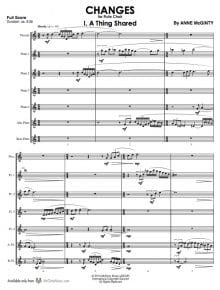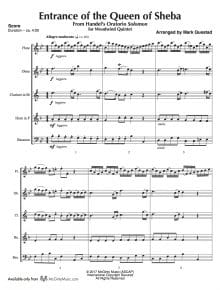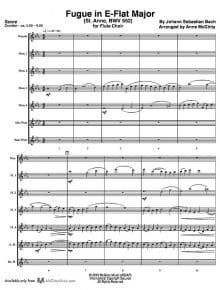Search Music
Music Categories
PDF Download Only
Purchase. Print. Play.
-
Changes – Flute Choir
M.F.K. Fisher, in her book The Gastronomical Me, wrote poignant stories of her life and career based on memorable meals and her experiences with food. When asked by Julia Child why she chose food and hunger for these stories, Mrs. Fisher replied, “When I write about hunger, I am really writing about love and the hunger for it, and warmth, and the richness and fine reality of a hunger satisfied.”
Changes tries to capture that warmth and richness and reality musically. The titles of the three movements are chapter titles from this book, with the music reflecting the many changes that are an inevitable part of living.
The first two movements are both slow and reflective. In the first movement each instrument has something to say and shares it with the others, with the resulting interchanges both bitter and sweet. The second movement, dreamlike as suggested by the title, recalls big dreams as well as little dreams—success, frustration and finally satisfaction. The final movement is playful and at times humorous, with a flurry of notes and amusing syncopations, a drastic change from the first two movements. The ending, with tongue in cheek and consideration of the meter used, is indeed a feminine ending in the classical sense as it does end on the second beat.
The sample score shows the first page of each of the three movements. At this time there is no recording available.
Composer: Anne McGinty
Instrumentation: Piccolo, 4 C Flutes, Alto Flute & Bass Flute
Duration/# of Pages: ca. 9:30 / 48 pages, 8.5″ x 11″
Key: N/A -
Die himmel erzählen die Ehre Gottes (Schütz) – Flute Choir
Heinrich Schütz (1585 – 1672) was a Renaissance composer is regarded as the most important German composer prior to Johann Sebastian Bach. His compositions show the influence of his teacher, Gabrieli.
One of the last composers to write in modal style, the text for this
piece is from Psalm 19. The title translates to: The heavens are telling the glory of God.Originally written for six voices, the piece is ideal for flute choir and will sound glorious in a church or recital setting.
The Ohio State University Flute Troupe, directed by Katherine Borst Jones, recorded this piece. The full version is available for your listening pleasure under the “Hear an Excerpt” link.
Composer: Anne McGinty
Instrumentation: Piccolo, 4 Flutes, Alto Flute & Bass Flute
Duration/# of Pages: ca. 3:45 / 24 pages, 8.5″ x 11″
Key: N/A -
Entrance of the Queen of Sheba – Woodwind Quintet
This piece is a sinfonia with which George Friderik Handel began the third act of his oratorio, Solomon. This lively and festive processional is often played during wedding ceremonies. The flute, oboe and clarinet players will definitely enjoy playing this piece.
Composer: Mark Questad
Instrumentation: Flute, Oboe, Clarinet, F Horn & Bassoon
Duration/# of Pages: ca. 4:00 / 24 pages, 8.5″ x 11″
Key: Bb -
Fugue in E-Flat Major (J.S. Bach) – Flute Choir
“The triple fugue … is a symbol of the Trinity. The same theme recurs in three connected fugues, but each time with another personality. The first fugue is calm and majestic, with an absolutely uniform movement throughout; in the second the theme seems to be disguised, and is only occasionally recognisable in its true shape, as if to suggest the divine assumption of an earthly form; in the third, it is transformed into rushing semiquavers as if the Pentacostal wind were coming roaring from heaven.” ~ Albert Schweitzer
The Fugue in E-Flat Major (BWV 552) has become known in English-speaking countries as the “St. Anne” because of the first theme's resemblance to the St. Anne hymn O God, Our Help in Ages Past, a hymn that would have been unknown to Bach. A fugue in three sections of 36 bars, 45 bars and 36 bars, with each section a separate fugue on a different theme, it has been called a triple fugue, although only the first theme is combined with the second and third themes; for that reason the second and third sections are sometimes referred to as double fugues. The number three is pervasive and has been understood to represent the Trinity. The description of Albert Schweitzer follows the nineteenth century tradition of associating the three sections with the three different parts of the Trinity. The number three, however, occurs many other times: in the number of flats of the key signature; in the number of sections; and in the number of bars in each section, each a multiple of 3 x 3. Each of the three themes of the fugues seems to grow from the previous ones.
Written for organ, the ranges of each of the five fugal voices works well for flute choir. Articulations and minimal dynamic suggestions have been added to honor the music, to make it sound as it would have sounded if the fugue were conceived for these modern instruments.
Composer: Anne McGinty
Instrumentation: Piccolo, 4 C Flutes, Alto Flute & Bass Flute
Duration/# of Pages: ca. 5:30 / 35 pages, 8.5″ x 11″
Key: Eb




